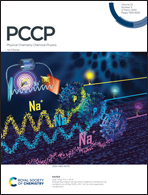Charge fluctuation drives anion rotation to enhance the conductivity of Na11M2PS12 (M = Si, Ge, Sn) superionic conductors†
Abstract
Solid superionic conductors exhibit good battery safety and stability, promising to replace organic liquid electrolytes. However, a comprehensive understanding of the factors determining high ion mobility remains elusive. Experiments have confirmed that the Na11Sn2PS12 superionic conductor has high room temperature Na+-ion conductivity; excellent phase stability has been demonstrated in a solid-state electrolyte. The PS4 anion rotation exists in Na11M2PS12-type superionic conductors, but this rotation is affected by the isovalent cation substitutions of the M site. In combination with ab initio molecular dynamic simulations and joint time correlation analysis of the AIMD data, we show that the transport of Na+ ions is directly enhanced by the charge fluctuation in their tetrahedral MS4 anions that comprise the framework. The fundamental reason for the charge fluctuation is the material structure forming a micro-parallel capacitor with MS4 anions, which governs the differential capacitance. Our study provides a fundamental and comprehensive understanding of the structure-controlled charge transfer of Na11M2PS12-type material and can guide solid-state battery optimization and design.

- This article is part of the themed collection: 2023 PCCP HOT Articles


 Please wait while we load your content...
Please wait while we load your content...